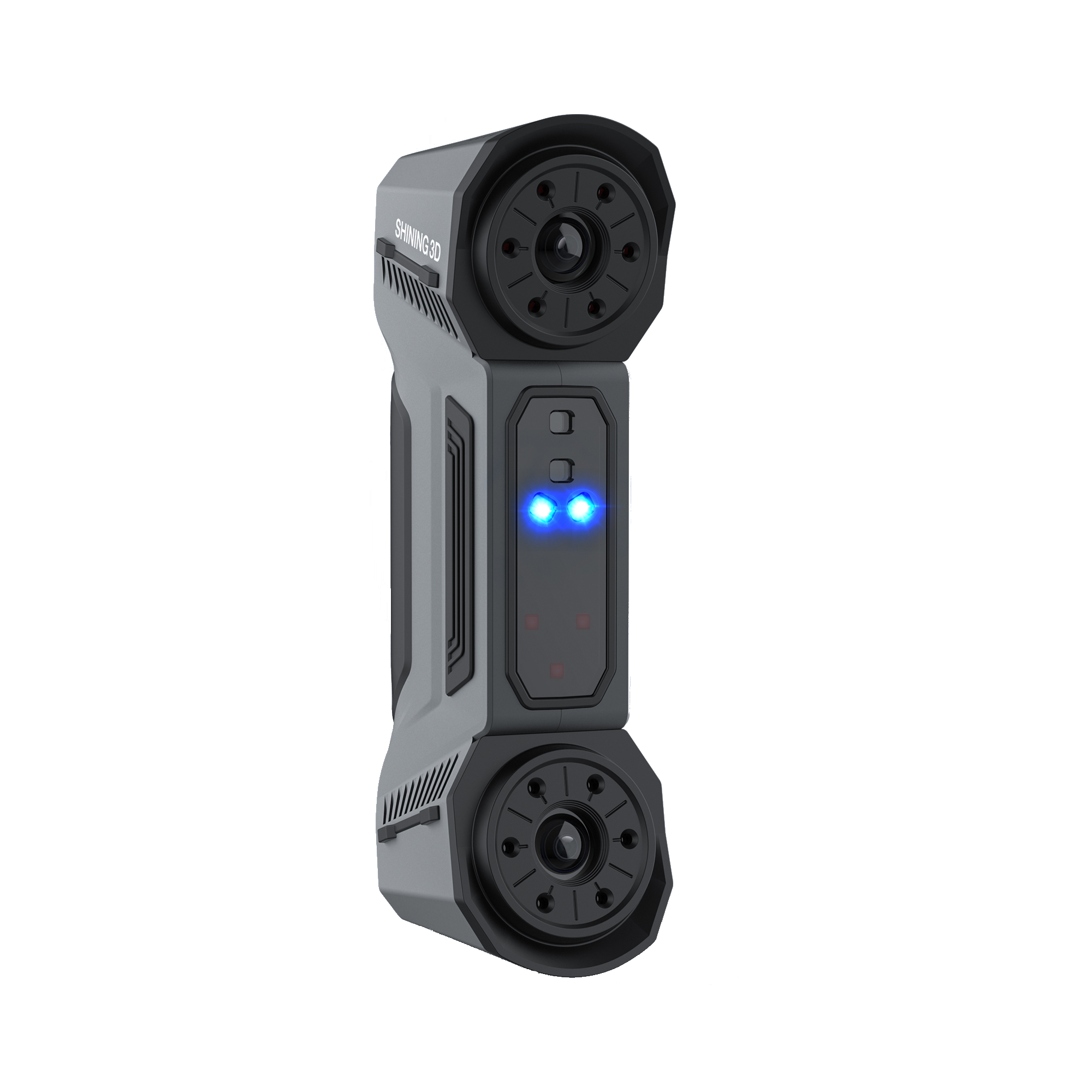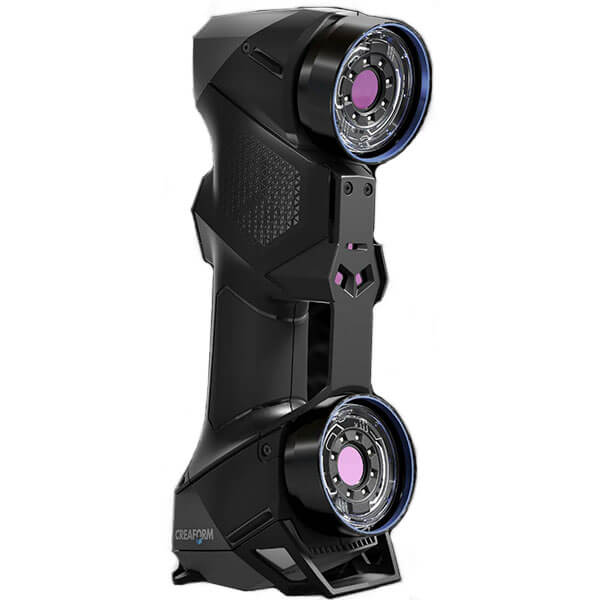The best metrology 3D scanners

What is 3D metrology?
3D metrology is the process of acquiring highly accurate physical 3D measurements of an object. The result is a digital 3D model that can be analyzed or retro-engineered.
In the case of quality inspection, for example, the 3D scan can be compared to a reference CAD model to make sure the object respects established norms and standards. 3D metrology helps ensure product quality while saving time and, thus, lowering costs.
CMMs– coordinate measuring machines– have traditionally been the most common type of hardware used for precision measurement. However, advances in 3D scanning technology are making 3D scanners increasingly popular for metrology as well, as they are faster and more cost-effective.
In this guide, we offer a comprehensive overview of some of the best metrology 3D scanners available on the market, covering different types of hardware (stationary, handheld) and price points. We also provide basic insight into 3D metrology software, which is as equally important as the hardware side of things.
Note: Not sure if you need an industrial metrology-grade performance? Take a step back and learn about other types of 3D capture solutions (jewelry 3D scanners, dental solutions, SLAM, …) in our all-round 3D scanner buyer’s guide.
The best metrology 3D scanners in 2023
The table below recaps our selection of some of the best metrology-grade 3D scanning options. The goal is to provide a quick, visual overview of the market; there are of course numerous other factors to consider beyond tech specs (certifications, software, customer service, …) to get the full picture for each solution and eventually make the right choice.
| Brand | Product | Accuracy | Country | Price
Approximate starting prices based on supplier-provided information and public data. Prices may vary by region, over time and do not include additional products or services (taxes, shipping, accessories, training, installation, …).
| |
|---|---|---|---|---|---|
| Creaform
Product data validated by the manufacturer.
| HandySCAN BLACK Elite
This product has been reviewed by our team.
| 0.025 mm | Canada | $ 65,000 | Quote |
| SCANTECH (HANGZHOU)
Product data validated by the manufacturer.
| NimbleTrack-C | 0.044 mm | China | upon request | Quote |
| SCANTECH (HANGZHOU)
Product data validated by the manufacturer.
| SIMSCAN-E | 0.02 mm | China | upon request | Quote |
| SCANTECH (HANGZHOU)
Product data validated by the manufacturer.
| KSCAN-Magic | 0.02 mm | China | upon request | Quote |
| Shining 3D
Product data validated by the manufacturer.
| FreeScan Combo+ | 0.02 mm | China | upon request | Quote |
| Shining 3D
Product data validated by the manufacturer.
| FreeScan UE Pro2 | 0.02 mm | China | upon request | Quote |
| Shining 3D
Product data validated by the manufacturer.
| FreeScan Trak Pro2 | 0.044 mm | China | upon request | Quote |
The products in the table are ranked by price (low to high).

| Brand | Product | Category | Accuracy | Max resolution | Price
Approximate starting prices based on supplier-provided information and public data. Prices may vary by region, over time and do not include additional products or services (taxes, shipping, accessories, training, installation, …).
| |
|---|---|---|---|---|---|---|
| Creaform
Product data validated by the manufacturer.
| HandySCAN BLACK Elite
This product has been reviewed by our team.
| Handheld | 0.025 mm | 0.1 mm | $ 65,000 | Get a quote |
| SCANTECH (HANGZHOU)
Product data validated by the manufacturer.
| NimbleTrack-C | Handheld | 0.044 mm | 0.02 mm | upon request | Get a quote |
| SCANTECH (HANGZHOU)
Product data validated by the manufacturer.
| SIMSCAN-E | Handheld | 0.02 mm | 0.02 mm | upon request | Get a quote |
| SCANTECH (HANGZHOU)
Product data validated by the manufacturer.
| KSCAN-Magic | Handheld | 0.02 mm | 0.01 mm | upon request | Get a quote |
| Shining 3D
Product data validated by the manufacturer.
| FreeScan Combo+ | Handheld | 0.02 mm | 0.05 mm | upon request | Get a quote |
| Shining 3D
Product data validated by the manufacturer.
| FreeScan UE Pro2 | Handheld | 0.02 mm | 0.01 mm | upon request | Get a quote |
| Shining 3D
Product data validated by the manufacturer.
| FreeScan Trak Pro2 | Handheld | 0.044 mm | 0.01 mm | upon request | Get a quote |
Overview of the best 3D scanners for metrology in 2023
In this section, we give some more context and information about each 3D scanner from our selection.
| Country | China |
| Max resolution | 0.05 mm |
| Accuracy | 0.02 mm |
| Volumetric accuracy | 0.02 mm + 0.033 mm/m |
| Acquisition speed | 3,600,000 points/s |
| Price | upon request |
Scanners from the powerful FreeScan Combo Series pack dual light sources in an ultra-compact shell, measuring just 193 x 63 x 53mm.
They’re equipped with both blue laser and infrared VCSEL technology and weigh in at only 620g.
This lightweight, handheld 3D scanner offers four modes: multiple-line scanning, single-line scanning, fine scanning, and infrared scanning.
Its multiple-line mode projects up to 50 laser lines (FreeScan Combo + version) and scan at speeds of up to 3,600,000 points/sec.
| Country | China |
| Max resolution | 0.02 mm |
| Accuracy | 0.02 mm |
| Volumetric accuracy | – |
| Acquisition speed | 6,300,000 points/s |
| Price | upon request |
The SIMSCAN-E is an intelligent, wireless, and palm-sized 3D scanner that combines a lightweight design with exceptional performance. Featuring advanced edge computing and wireless data transfer, it sets a new standard for flexible, wireless and free 3D scanning.
With robust algorithm and high-definition industrial cameras, SIMSCAN-E can capture 3D data with remarkable precision and efficiency, measuring up to 6.3 million points /s. It boasts three scanning modes, ultra-fast, hyperfine, and deep hole. This versatility allows it to handle a wide range of tasks effortlessly, from scanning in tight spaces to measuring complex structures.
| Country | Canada |
| Max resolution | 0.1 mm |
| Accuracy | 0.03 mm |
| Volumetric accuracy | – |
| Acquisition speed | 1,300,000 points/s |
| Price | $ 65,000 |
The BLACK Elite tops out Creaform’s flagship HandySCAN range, which we have reviewed several times over the years. It delivers a powerful performance that reminds us of the Metrascan 750, but without all the hurdles (complex setup, number of parts and accessories, and large footprint).
It boasts a clean, robust finish, and everything exudes quality and rigor. The attention to detail is similar to the feeling that Apple products give off; it’s no wonder Creaform received a Red Dot Design Award (2019) for it.
The HandySCAN BLACK Elite comes with Creaform’s VXelements software, which includes dimensional inspection modules (VX Inspect). It can also be used with third-party suites from Autodesk, 3D Systems, Dassault, etc. Users may opt for the Creaform MaxSHOT CMM add-on to complement the HandySCAN’s performance.
Read the full review: Creaform HandySCAN BLACK Elite review
| Country | China |
| Max resolution | 0.01 mm |
| Accuracy | 0.02 mm |
| Volumetric accuracy | 0.02 mm + 0.015 mm/m |
| Acquisition speed | 4,150,000 points/s |
| Price | upon request |
SCAN-Magic is lightweight and portable and can conduct 3D measurements anywhere and anytime regardless of vibrations, temperature, and humidity. Moreover, KSCAN-Magic is capable of 3D scanning various surfaces to capture precise 3D data, and it performs well even in 3D scanning reflective and black surfaces.
The KSCAN handheld 3D scanner boasts an exceptional scanning accuracy of up to 0.020 mm. When coupled with the MSCAN-L15 photogrammetry system, it excels even further by achieving a volumetric accuracy of 0.015 mm + 0.012 mm/m. This technology is pivotal in driving ultra-high precision Non-destructive Testing (NDT) catering to a diverse range of industries.
| Country | China |
| Max resolution | 0.02 mm |
| Accuracy | 0.04 mm |
| Volumetric accuracy | 0.044 mm + 0.012 mm/m |
| Acquisition speed | 4,900,000 points/s |
| Price | upon request |
The NimbleTrack-C is Scantech’s latest innovation in wireless 3D scanning systems. This compact, agile device is engineered to enable precise 3D measurements of small-to-medium-sized parts. Equipped with advanced on-board chips and a built-in battery, the NimbleTrack offers a fully wireless operation—both the scanner and optical tracker are untethered, allowing unmatched freedom in measurement tasks.
Key Features
- Wireless Measurement: Complete freedom with no cables required.
- Industrial-grade Precision: Accurate measurements for critical applications.
- On-board Edge Computing: Powerful processing directly on the device.
- Target-free 3D Scanning: Streamlined operation without the need for physical targets.
- Grab-and-go Design: Easy to transport and quick to deploy.
- High Frame Rate: Captures movement and detail at 120 frames per second.
| Country | China |
| Max resolution | 0.01 mm |
| Accuracy | 0.02 mm |
| Volumetric accuracy | 0.02 mm + 0.015 mm/m |
| Acquisition speed | 3,460,000 points/s |
| Price | upon request |
Based on the capabilities of FreeScan UE series, FreeScan UE Pro2 features an innovative integrated WIRELESS module for more flexibility and mobility. With its ultra-fast scan speed, efficiency is doubled, empowering quicker project completion.
The patented innovative built-in photogrammetry technology enhances volumetric accuracy, making it perfect for scanning a wide range of parts from small to large.
Additionally, the integrated inspection module facilitates on-site quality control, streamlining your workflow effortlessly with all-in-one shopfloor solution.
Ideal for inspections and versatile applications, FreeScan UE Pro2 sets a new standard in portable 3D metrology world.
| Country | China |
| Max resolution | 0.01 mm |
| Accuracy | 0.04 mm |
| Volumetric accuracy | 0.044 mm + 0.012 mm/m |
| Acquisition speed | 3,070,000 points/s |
| Price | upon request |
Shining 3D FreeScan Trak Pro2 overview
The FreeScan Trak Pro2 Portable Optical Coordinate Measuring System is the ideal metrology tool for quality control and 3D inspection. With high precision and repeatability, the FreeScan Trak Pro2 allows for fast, accurate inspection of various part types and surfaces without the need for markers.
When paired with the optional FreeProbe, users can seamlessly integrate contact probing to the optical scanning process for a swifter and more convenient overall inspection workflow.
Types of metrology 3D scanners
Handheld metrology 3D scanners
Handheld 3D scanners are convenient, versatile systems that grant access to hard-to-reach places (e.g. car interiors). They often feature several modes for users to adapt to small, medium, or large-sized parts.
Using a handheld 3D scanner is comparable to recording a video or painting with a brush; the subject must be captured from all angles.
Stationary metrology 3D scanners
A stationary 3D scanner is similar to a camera on a tripod. For small or medium-sized objects, these scanners are usually paired with an automatic turntable for smoother workflows.
They can also be mounted onto an automated station. Such systems generally move the scanner up and down along the Z-axis while the object to be scanned sits onto an attached turntable.

Stationary scanners are often more accurate solutions due to their fixed setup but are impractical for large objects or infrastructures. That said, some are robot-mountable.
Automation in metrology with robotic arms
Many metrology 3D scanners, mostly in the stationary category, are designed to be mounted onto an industrial, robotic arm depending on specific needs.
Here is an example from Scantech:
These 5-axis or 6-axis arms eliminate human errors and speed up the scanning process. Robotic 3D scanning arms are often used in assembly lines.
High-end industrial 3D metrology systems
For our main selection, we didn’t include high-end systems that are destined for heavy industrial applications. They can’t be compared on the same level as the scanners from our main list, whether it’s in terms of accuracy, pricing, software, or automation.
Several leading brands like Hexagon and GOM (which is now part of ZEISS) provide extremely accurate, automated 3D scanning solutions for industrial assembly lines.
Contact us for more information.
3D scanner vs CMM
CMM stands for coordinate measuring machine. This type of device uses a probe- either a physical, surface-touching probe or a light/laser source–to measure an object’s geometry. CMMs can be operated manually or computer-controlled.
These machines are highly accurate but are relatively slow at capturing data and only acquire a certain amount of points. A standard CMM captures several hundred points, in contrast to 3D scanners which acquire hundreds of thousands or millions of points.
Hence, CMMs are mostly used for targeted inspection rather than for providing full 3D models of objects, in which case 3D scanners are the best option.
The main advantages of 3D scanners over CMMs are:
- Speed: A 3D scan can be processed in a matter of minutes, while CMMs require more time.
- Automation: 3D scanning systems are much more compatible with industrial environments such as assembly lines.
- Scope: 3D scanners capture exponentially more information. This can allow engineers and designers to understand what the root cause of a potential part deformation is rather than simply identifying its existence. They can also scan much larger parts than CMMs, which have a fixed frame/volume.
- Flexibility: It is easier to relocate a 3D scanner and use it at several workstations to adapt to different production needs. CMM machines generally stay in one place and take up a large amount of space.
- Non-intrusive: While coordinate measuring machines don’t necessarily all need to physically touch the object, they do get close to the object, which can be a problem in some cases. 3D scanners can capture data at a safe distance.
- Price: 3D scanners are generally less costly acquisitions than CMM machines.
All of this being said, CMMs and 3D scanners can be complementary. CMMs are hard to beat when it comes to measuring holes and complex, intricate details.
By using both a CMM (such as a handheld probe) and a 3D scanner, it is possible to reach a high level of accuracy.
Which industries use metrology and why?
Integrating 3D metrology directly in the value chain of any industry ensures high part quality without interrupting the production line.
These are some of the many industries that take advantage of 3D metrology:
- Aerospace and automobile
- Electronics
- Power and energy
- General manufacturing
- Medical
- Tooling
The top application for 3D metrology is part inspection within general quality control processes. It is essential for any business to oversee that their manufactured goods are up to standard.
This is true whether these goods are simple household objects, like a microwave knob, or crucial airplane parts that must be 100% standard and safe.
Accurate 3D measurement data also provides the option to reverse-engineer replacement parts and make quick repairs.
Overall, using 3D metrology ensures fewer errors in production, saving both time and money.
You may also like:
What is reverse engineering?
Metrology software for inspection
A 3D scanner is only as good as the software it works with. For clarity, we can distinguish two kinds of software:
- Base software to operate the scanner: This is typically proprietary software (e.g. Artec Studio) that is included with the scanner to convert the data points and clouds into a 3D mesh of the scanned object. It offers basic functionalities such as mesh alignment and hole filling, but usually won’t be enough to perform advanced inspection and quality control operations.
This can be sufficient depending on the end-use of the scan, but when it comes to metrology, additional software is often needed.
- Software for inspection: For 3D metrology, engineers and designers use specific inspection software or modules with additional functionalities and power. Indeed, the primary goal (among others) is to compare the 3D scan to a reference CAD file. The software must be able to do that in order to find potential discrepancies and deliver deviation maps or reports.

3D inspection software: what’s available?
In most cases, manufacturers either provide their own software or recommend third-party suites.
- Proprietary software: The manufacturer can develop their own separate inspection software, like GOM with GOM Inspect, which is a reference in the industry. Other proprietary inspection software suites for 3D scanners include:
- Creaform VXelements and VXinspect module
- FARO CAM2 2020
- ScanTech ScanViewer
- PolyWorks Inspector
- Third-party software: Manufacturers can recommend or bundle in a particular third-party software. Some of the most renowned, “universal” metrology 3D scanning software suites include:
- 3D Systems Geomagic Control X
- Verisurf Inspect
- Siemens NX
- GOM Inspect (comes with GOM scanners but is also recommended by other manufacturers)
Of course, there are exceptions to this distinction. Some manufacturers directly include inspection-type functionalities within their base software, like ScanTech with ScanViewer or GOM with GOM Inspect.
Conversely, sometimes inspection software is capable of serving as base software by importing and processing raw 3D scanning data, too.
You may also like:
An overview of 3D scanning for part inspection
3D scanning software pricing
Metrology and inspection software prices are quite high, sometimes even higher than the hardware itself. They can cost anywhere from several thousand dollars to over $30,000 and are not always included in the 3D scanner’s price, so it is something to watch out for when choosing a scanner.
If you already have a license for a specific inspection software suite, you can also check which scanners are compatible with it.
What specifications to look for in a 3D scanner?
There are several specifications to look into before purchasing a 3D scanning solution for metrology.
Accuracy
Accuracy defines how close a measurement is to its true value. This is of utmost importance for metrology applications. Often, manufacturers provide two different kinds of accuracy specifications: single scan accuracy and volumetric accuracy.
Learn more:
3D scanner accuracy and resolution: The basics
Light source
3D scanners use different kinds of light sources to capture 3D images: laser lines and crosses, which are typically red or blue; or LED light patterns, which are usually white or blue.
Generally, the more lines or lasers a 3D scanner has, the faster it will be at 3D scanning.
Resolution
Resolution is typically measured in point-to-point distance, and sometimes in points per scan.
As is the case with images, the higher a scan’s resolution is, the more details will be visible and the crisper the results will be.
There are two different kinds of resolutions: measurement resolution and mesh resolution. Mesh resolution is the most important kind to consider, as it will be the resolution of your final 3D model.
It may at times be unclear which resolution manufacturers are referring to in their product specifications.
Speed
Data acquisition speed can be expressed in point measurements per second, frames per second, or seconds per scan.
Software
Some 3D scanner manufacturers develop their own software, while others have partnerships with existing, leading 3D scanning software brands.
It is also important to keep in mind that 3D scanning software always requires powerful laptops in terms of RAM, graphics cards, etc. If you are not well equipped, you may need to allocate several thousand dollars of your budget to a new PC.
Range and field of view
Evidently, it is inefficient to 3D scan a large object with a 3D scanner that has a small range or field of view. Hence it is mandatory to see if a scanner’s range is compatible with what you are planning on 3D scanning.
Some 3D scanners offer multiple 3D scanning modes to adapt to different object sizes.
Marker placement
Markers are small, adhesive “targets” that aid 3D scanners in positioning the data that they have acquired. In other words, they help the scanner align the different captured frames together, relatively to each other and in space, to form the 3D model.
In order to enhance their global accuracy, a number of structured light or laser 3D scanners integrate marker acquisition with photogrammetry technology, through dedicated cameras.
They are in a way “hybrid” 3D scanners, explaining why some metrology 3D scanners require the user to place markers on the object to be scanned or its environment, especially for large-sized objects (over 1 meter).
Metrology 3D scanner price
The price for a metrology 3D scanner largely depends on its accuracy, software, and other factors. For heavy industrial applications, the price for an appropriately accurate scanner and software can go well over $100,000.
For less demanding use cases, the price for an entry-level metrology 3D scanner can start at around $15,000.
FAQ
Metrology-grade 3D scanners generally cost between $20,000 and $50,000. Industrial, robotic automated systems can cost over $100,000.
Currently, accuracy can get all the way down to 0.004 mm- 16 times thinner than an average human hair.
The maximum scanning area depends on the scanner itself. Keep in mind that the bigger the scan, the less accurate the result will be (linearly).
It is possible to do metrology with a handheld 3D scanner. For repeated industrial applications, however, stationary or automated scanners are preferable.
Depending on the 3D scanner’s speed and the object’s complexity and size, it can take anywhere from less than a minute to several dozen minutes. Software processing adds a bit of time to the total.
Shiny and dark objects are hard to 3D scan, regardless of the 3D scanner’s quality. Special sprays and techniques exist to overcome this obstacle.
 English
English  Français
Français








